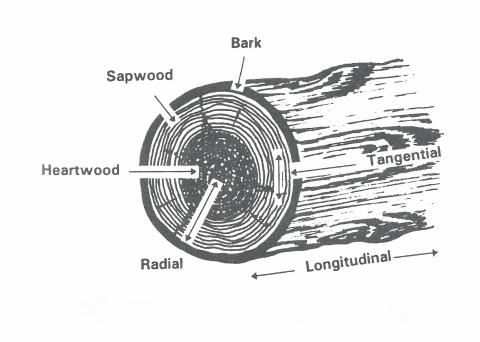Wood
S. R. Garcia, I. M. Godfrey and S. Lussier
Introduction
Wood is a widely used and well known material. Although its general properties are familiar to most people there is an underlying complexity to wood that is not widely appreciated. It is a natural substance made up of countless individual cells. These cells and their contents are composed primarily of:
- water;
- polysaccharides (hemicelluloses and cellulose);
- polyphenolics (lignin); and
- extractives which are usually present in small quantities. These may affect the colour and odour of the wood.
Examination of the cross-sectional surface of a tree trunk reveals three distinct zones: the bark, the light-coloured outer region (the sapwood) and the dark-coloured inner region (the heartwood). It is the heartwood that is used in furniture, building, sculpture and the thousands of other common uses to which wood is put (Figure 1).
Figure 1: A child’s toy merry-go-round made from painted wooden clothes pegs.
The tangential and radial directions may be identified on the cross-sectional surface (Figure 2). Wood properties vary in these and the longitudinal direction. For instance, when wood dries its shrinkage is greatest in the tangential (5 - 10 %) and least in the longitudinal (less than 0.1 %) directions.
Figure 2: Wood – cross-section of a typical tree trunk.
From the time a tree is felled it begins to lose moisture, first at the surface and eventually from deeper within the wood. The rate at which green timber dries depends on environmental conditions and the type of wood. It is a challenge to timber specialists to dry wood without warping, cracking and splitting. Seasoned dry wood continues to interact with its surroundings, absorbing or releasing water in response to changes in the relative humidity of its environment.
Wood samples are usually classified as either hardwoods or softwoods. These classifications are not related to the hardness or the softness of the materials, being based primarily on the presence of pores (hardwoods) or their absence (softwoods). Balsa for example, despite its inherent softness, is a hardwood.
There are also fundamental differences in the usual physical characteristics of the trees from which these timber types are derived. These are listed below:
| Hardwood | Softwood |
|---|---|
| broad leaves | needles |
| deciduous or evergreen | evergreen |
| flowers or seeds | cones or seeds |
| complex cellular structure | less complex |














